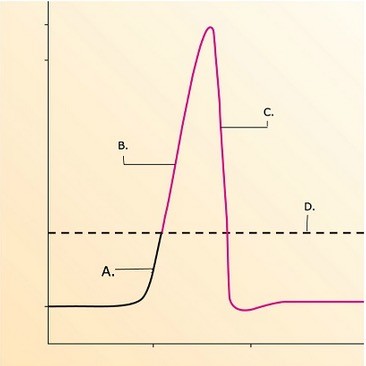 What does "B" represent on the diagram?
What does "B" represent on the diagram?
A. Depolarization
B. Threshold
C. Depolarization phase of action potential
D. Repolarization phase of action potential
Answer: C
You might also like to view...
Which vessel in the diagram is the interlobular artery?
a) D b) E c) F d) L
The nonpregnant uterine wall consists mostly of ________.
A. myometrium B. perimetrium C. endometrium D. dense irregular connective tissue E. dense regular connective tissue
Which of the following bones is part of the cranium?
A. Vomer B. Mandible C. Occipital bone D. Palatine bone E. Nasal bone
Which of the following represents the correct sequence of steps in deglutition?
A. The larynx pushes up, causing the epiglottis to close over the glottis - the tongue pushes the bolus back to the pharynx - peristalsis moves the bolus toward the stomach - the bolus moves into the esophagus. B. The larynx pushes up, causing the epiglottis to close over the glottis - the tongue pushes the bolus back to the pharynx - the bolus moves into the esophagus - peristalsis moves the bolus toward the stomach. C. The tongue pushes the bolus back to the pharynx - the larynx pushes up, causing the epiglottis to close over the glottis - the bolus moves into the esophagus - peristalsis moves the bolus toward the stomach. D. The tongue pushes the bolus back to the pharynx - the bolus moves into the esophagus - the larynx pushes up, causing the epiglottis to close over the glottis - peristalsis moves the bolus toward the stomach.